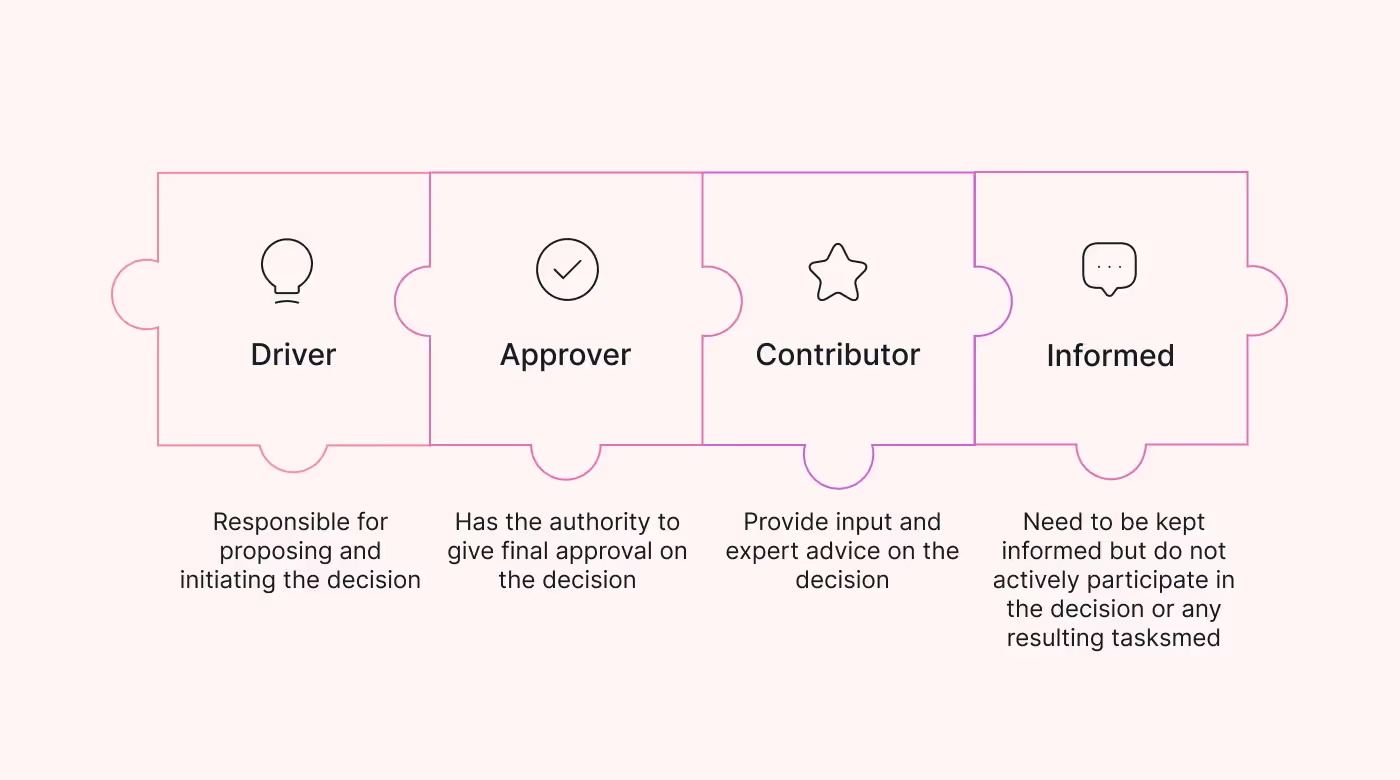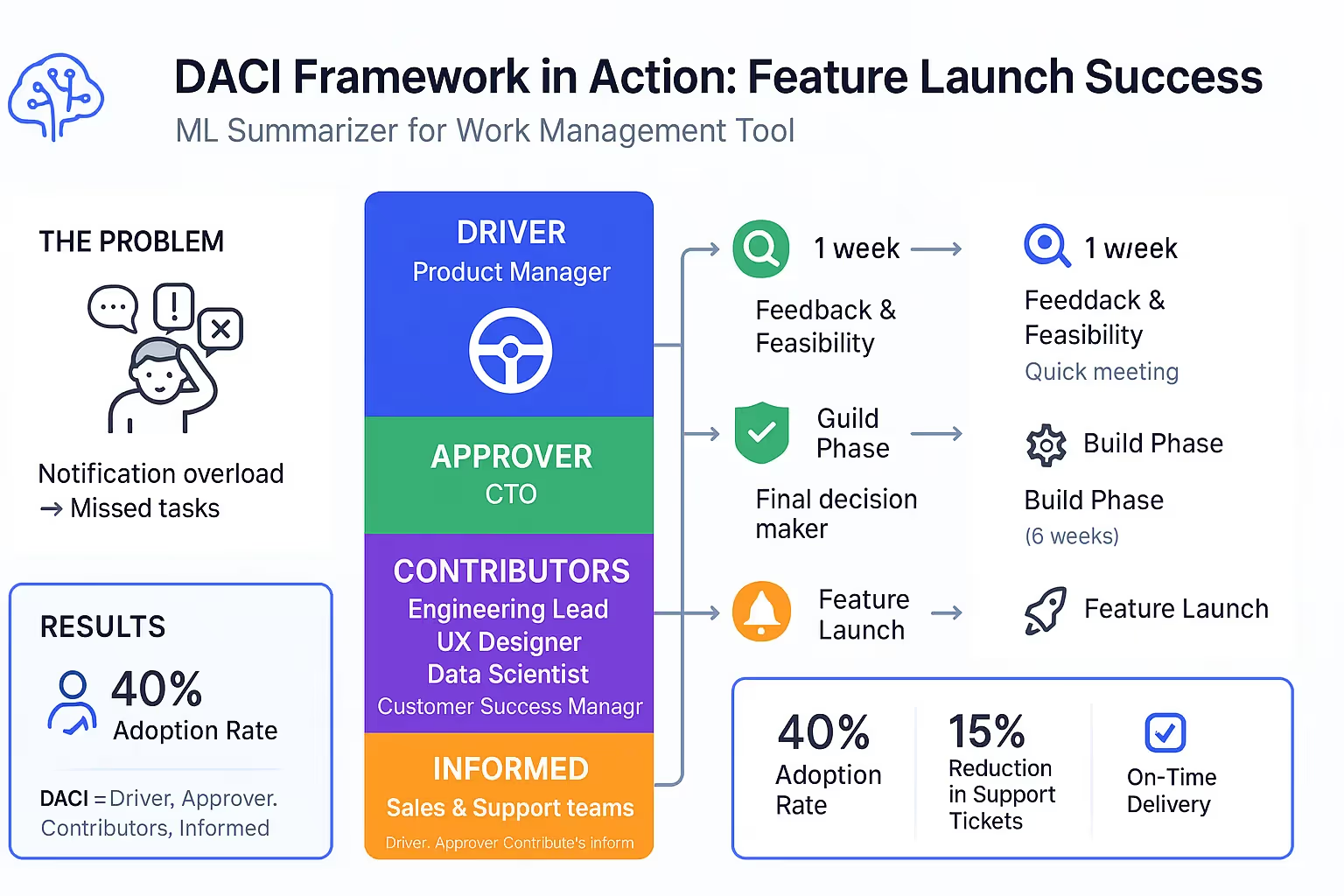What Is a DACI Framework? Guide (2025)
Learn about the DACI framework for decision‑making, including the roles of driver, approver, contributors, and informed stakeholders.

When you run a small startup, the next decision can make or break your week. You sketch a new feature, call a huddle and suddenly you’re debating for hours. Roles blur, approvals drag and enthusiasm fades. If this feels familiar, you might ask yourself what is a DACI framework. It’s a simple way to bring clarity and pace to important calls.
This guide is for founders, product managers and design leads who are juggling multiple hats. It explains the central idea behind the DACI model, shows how to apply it to cross‑functional decisions, compares it to other approaches and warns against common missteps. You’ll also read a short story of how one team used it to launch a new feature. By the end you’ll know when to pick up this tool and how to make it yours.
What is the DACI framework?
DACI stands for Driver, Approver, Contributors and Informed. It was born at Intuit in the 1980s as a variant of the better known RACI matrix. ProductPlan observes that the model improves team effectiveness and velocity by assigning clear roles and responsibilities. Each letter describes a person’s part in a decision:
- Driver – the person who leads the process and keeps momentum. They gather input, prepare documents and move the decision forward.
- Approver – the single person who makes the final call. Atlassian emphasises that naming one approver keeps things moving.
- Contributors – domain experts who provide input. They inform the decision without owning it.
- Informed – people who are kept in the loop. They don’t shape the decision but need to know the outcome.

Calling it a framework is apt because it’s more than a list of roles. The model outlines a step‑by‑step approach for making calls quickly and with accountability. Unlike general responsibility matrices, DACI focuses on decisions rather than tasks. That distinction makes it ideal for product choices where speed and quality both matter.
Why early‑stage teams should care
Understanding what a DACI framework does helps you allocate roles for each decision instead of relying on job titles. This clarity speeds up your team and reduces confusion when everyone is wearing multiple hats.
Early‑stage teams often make calls that cross product, design, engineering and go‑to‑market. Without clarity, feedback loops become endless and nobody owns the outcome. Product management experts Brian Lawley and Pamela Schure stress that product teams work on several fronts at once and need decision clarity. DACI offers that structure.
Here’s why it matters:
When founders ask what a DACI framework is, the answer is that it’s a tool to cut through noise and get moving again.
- You move faster. Projects that use DACI have a 25% higher success rate in meeting objectives and timelines. When everyone knows who decides and who contributes, decisions stop drifting.
- You avoid confusion. Mapping roles prevents the “too many cooks” problem. A small group of contributors feeds the driver; one approver decides.
- You improve shared understanding. Input from design, engineering, data and marketing leads to balanced outcomes. This is vital for early products where a single misstep can cost months.
- You build accountability. By tracking who made which call, you can tie decisions to outcomes. Forbes reports that half of companies stagnate by failing to track and fix bad decisions. Recording decisions in a DACI document helps teams learn and improve.
When you’re measuring things like time to value or retention, the way you decide feeds into your metrics. DACI makes those links explicit. It’s like having clear learning goals and assessments in education; you know what you’re working towards and how you’ll measure progress.
Putting DACI to work
Applying DACI is straightforward. Here’s a condensed process, adapted from Atlassian’s playbook and our own practice:
- Set up a decision document. Write a short brief explaining what needs to be decided, the context, options and deadline.
- Pick a driver. Choose one person to coordinate. They gather data, schedule discussions and ensure contributors’ voices are heard.
- Define the scope. Clarify the question you’re answering to prevent scope creep.
- Invite contributors. Select a small group of subject‑matter experts whose input is essential.
- Name an approver. Identify the person with authority to decide. Keep this to one for speed.
- List who needs updates. Decide who should be informed and how you’ll notify them.
- Make the call and record it. The driver synthesises the input and briefs the approver, who decides. Document the rationale and share the outcome.
Once you grasp what a DACI framework is, following these steps becomes second nature.
A simple table keeps this clear:
Don’t overcomplicate the process. As long as everyone sees the same information, the approach works.
Comparing DACI to other frameworks
DACI is sometimes confused with RACI. In RACI, Responsible people do the work, Accountable people own the outcome, and Consulted and Informed roles mirror contributors and inform. The main differences:
- DACI adds a driver to steer the process.
- DACI pushes for a single approver, while RACI often names multiple accountables which can slow things down.
- RACI applies to task ownership; DACI focuses on decision‑making.

Other models exist. Bain & Company’s RAPID assigns roles to suggest options, gain agreement, perform tasks, give input and decide. The DECIDE model outlines steps from defining the problem to evaluating the result. The OODA loop (Observe, Orient, Decide, Act) comes from military strategy and emphasises speed. VPEC‑T examines values, policies, events, content and trust. Each model serves a purpose. The question of what a DACI framework is answered by focusing on cross‑functional product choices where clarity of authority is essential.
Where DACI fits (and doesn’t)
If you’re comparing RACI to DACI and still asking what is a DACI framework, centre your attention on who decides rather than who does the work.
You don’t need DACI for everything. It works best when a call has a broad impact or spans functions:
- Product priorities. Choosing what to build next affects many teams. A DACI maps roles across product, design and engineering.
- Launch planning. Deciding pricing or messaging involves product, marketing and sales. DACI keeps roles clear.
- Design shifts. Major changes to the user interface benefit from multiple inputs.
- Hiring or technology choices. Selecting a new stack or a critical hire often cuts across departments.
Use simpler methods for bug fixes, small design tweaks or obvious decisions. In a tiny team of two or three, roles are already clear. Adding a framework would only slow you down.
Knowing what a DACI framework is helps you decide when to use it and when to keep things informal.
As your startup grows, adapt DACI. In early days one founder might be the approver for most calls. Later you may need department heads to drive and executive leadership to approve. The process remains the same; only the people change.
Avoiding common mistakes
Frameworks can become burdens if applied poorly. Common pitfalls include:
- Too many approvers. Multiple decision‑makers cause delays. Atlassian advises naming a single approver.
- Driver and approver roles blurred. If one person does both, confusion arises. Keep them distinct.
- Contributor overload. Inviting every stakeholder dilutes input. Pick only those who add real value.
- Neglecting the informed group. Stakeholders left in the dark feel frustrated. Decide how you’ll share updates.
- Applying DACI to every task. Use it for high‑impact decisions; skip it for trivial ones.
Set criteria before using DACI, limit how many calls require it and review the process after each decision to make sure it still helps.
Measuring the impact
To see if DACI works, track a few metrics:
- Time to decide. Measure how long it takes from initiating a decision to the final call.
- Number of contributors. Too many suggests scope creep; too few may mean missing perspectives.
- Stakeholder satisfaction. Ask contributors and informed parties if they felt heard and updated.
- Outcome metrics. Look at product results like adoption, churn or support tickets.
Keep a decision log with the date, roles, rationale and outcomes. According to Forbes, companies that don’t track decisions stagnate. By logging decisions you create an audit trail and learn what works.
A handy checklist and tools
When you’re ready to apply DACI, use this checklist:
- Is this called high impact and cross‑functional? If yes, proceed.
- Assign a driver and an approver. Make sure they aren’t the same person.
- Select a few contributors and let them know their role.
- List who needs updates and agree on a communication channel.
- Write a brief decision document and share it early.
- Gather input, make the call and document the outcome.
- Review the process afterward to refine your approach.
You can adapt the simple table from earlier as your template. Keep it in whatever tool your team already uses. The goal is clarity, not process for its own sake.
Case story: a feature launch done right
To see DACI in action, imagine a SaaS company building a work management tool. They’re considering adding a machine‑learning summariser to help users digest long task lists.
They create a brief describing the problem: customers miss tasks due to notification overload. The driver is the product manager; the approver is the CTO; contributors include the engineering lead, the UX designer, the data scientist and a customer success manager. Sales and support are informed.
The driver collects customer feedback and feasibility input from contributors. After a short meeting, the CTO approves a prototype. The team builds the summariser in six weeks. Adoption reaches 40% of active users in a month, and support tickets related to missed tasks drop by 15%. Because roles were clear, discussions stayed focused and the launch met its deadline.

Conclusion
The question of what a DACI framework isn’t academic; it’s a practical tool for teams that need to make decisions quickly without leaving anyone in the dark. By assigning a driver, an approver, contributors and informed parties, you remove guesswork and keep momentum. This leads to faster calls, fewer misunderstandings and better outcomes. Use DACI when a decision spans departments or has significant impact, keep it light for simple tasks and always review your process. If you adopt it with discipline, you’ll spend less time in meetings and more time shipping.
Now that you know what a DACI framework is, you can apply it to your next big call with confidence.
Frequently asked questions
1) What is the DACI framework?
It’s a decision‑making model where the Driver steers the process, the Approver makes the call, Contributors provide input and Informed parties stay updated. It originated at Intuit as a variant of RACI and is designed to improve team effectiveness.
2) How does DACI differ from RACI?
RACI assigns who is responsible and accountable for tasks. DACI focuses on decisions and adds a Driver role while limiting approvers.
3) When should I use DACI?
Use it for cross‑functional or high‑impact calls like product roadmaps, launch planning, major design shifts or critical hires. Don’t use it for routine work or obvious decisions.
4) What are other decision frameworks?
RAPID, which gives roles for suggesting options, agreeing, performing, giving input and deciding, along with DECIDE, OODA and VPEC‑T, are models that suit different contexts. Each has its own focus.
5) Can one person hold more than one role?
In very small teams, yes. A driver might also contribute expertise. Just be clear when they’re coordinating versus deciding.
6) How often should I revisit my DACI setup?
Review after each major call. Adjust roles or processes based on what you learn.
7) Does DACI work with agile methods?
Yes. DACI complements agile rituals by clarifying who decides within sprints and retros. It doesn’t replace agile; it helps decisions move faster.




.avif)








